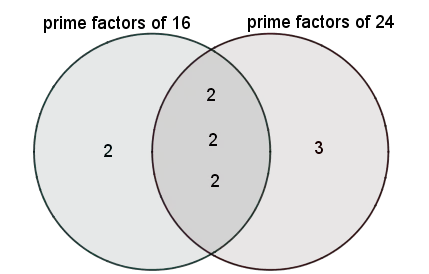GCF Calculator
GCF - work with steps
Input Data :
Data set = 5, 20, 40, 80, 100
Total number of elements = 5
Objective :
Find the GCF of given integers?
Solution :
Find prime factors for each input
5 = 5
20 = 2 x 2 x 5
40 = 2 x 2 x 2 x 5
80 = 2 x 2 x 2 x 2 x 5
100 = 2 x 2 x 5 x 5
Common factor for 5, 20, 40, 80, 100 is 5
GCF calculator uses two or more numbers and calculates the greatest common factor, i.e. the greatest factor that two or more integers have in common. It is an online mathematical tool specially programmed to find out the greatest common factor of the given numbers.
It is necessary to follow the next steps:
- Enter two or more numbers in the box. These numbers must be integers and may be separated by commas. The values can be copied from a text document or a spreadsheet;
- Press the "GENERATE WORK" button to make the computation;
- GCF calculator will give the greatest common divisor of two or more numbers.
Output : The greatest common factor is an integer number.
The GCF calculator determines the greatest common divisor of two or more integers using the prime factorization.
| Integers | GCF |
|---|---|
| GCF of 12 and 18 | 6 |
| GCF of 16 and 24 | 8 |
| GCF of 126 and 36 | 18 |
| GCF of 12, 30 and 72 | 6 |
| GCF of 170 and 210 | 10 |
| GCF of 14 and 15 | 1 |
| GCF of 18 and 36 | 18 |
| GCF of 16 and 20 | 4 |
| GCF of 14 and 28 | 14 |
| GCF of 15 and 20 | 5 |
| GCF of 18, 36 and 45 | 9 |
| GCF of 6 and 72 | 6 |
| GCF of 21 and 30 | 3 |
| GCF of 7, 15 and 21 | 1 |
| GCF of 24 and 8 | 8 |
| GCF of 49 and 98 | 49 |
| GCF of 8, 18 and 70 | 2 |
| GCF of 210 and 90 | 30 |
| GCF of 42, 28 and 70 | 14 |
| GCF of 90 and 135 | 45 |
| GCF of 758 and 21 | 1 |
What is Greatest Common Factor?
Integers sometimes have some of the same factors. The greatest number that is a factor of two or more integers, which are not all zero, is called the greatest common factor (GCF for short). The greatest common factor is also known as the greatest common divisor (GCD), highest common factor (HCF), or highest common divisor (HCD).
The greatest common factor of two integers $x$ and $y$ is usually denoted by $GCF(x,y)$ or $(x,y).$Because every nonzero integer number is a factor of $0$, then $GCF(x,0)=x,$ for any integer number $x$.Moreover, $GCF(0, 0)$ is not defined.
Two numbers are relatively prime or coprime if their only common factor is $1$.
In other words, two numbers $x$ and $y$ are {relatively prime} if and only if $GCF(x,y)=1.$ For example, $7$ and $9$ are relatively prime.
We can also find the GCF of two or more monomials by finding the product of their common prime factors. For example, the GCF of monomials $40x^2$ and $16x$ is $8x$, or mathematically written $(40x^2,16x)=8x.$
In general, the GCF can be a number, a variable or a combination of numbers and variables.
How to Find GCF of Two or More Numbers?
There are several methods for finding GCF of two integers. The same procedures can be applied to more than two integers. For example, let us find the GCF of $16$ and $24$.
- Listing the factors.
factor of $16$: $1,2,4,8,16$;
factor of $24$: $1,2,3,4,6,8,12,24$.
- Using prime factorization.
$16=2\times2\times 2\times 2$
$24=2\times 2\times 2\times 3.$
- Euclidean Algorithm.
$24-16=8$
$16-8-8=0$
So, the GCF of $16$ and $24$ is $16$.
- Venn diagram.

- Factor Trees.

A factor tree can also be used to find the GCF. First, identify the common factors. The numbers $16$ and $24$ have the factors $2,2$ and $2$ in common. The GCF is the product of the common prime factors. If the numbers have no factors in common using a factor tree, then the GCF of these numbers is $1$.
The GCF work with steps shows the complete step-by-step calculation for finding the greatest common factor of a given set of integers: $5, 20, 40, 80, 100$ using the prime factorization. For any other set of numbers, just supply the list of numbers and click on the "GENERATE WORK" button. The grade school students may use this GCF calculator to generate the work, verify the results derived by hand or do their homework problems efficiently.
Real World Problems Using GCF
The GCF is most often used in simplifying fractions because simplified fractions are useful in representing some measurements. If the GCF of the numerator and the denominator is $1$, then the fraction is in the simplest form. When we write the prime factorization of the numerator and the denominator and divide them by the GCF, we get the simplest form of the fraction. In the same manner, algebraic fractions can be written in the simplest form.
The GCF and LCM of two integers related to each other through
where LCM is the least common multiple.
The real life problems can be translated into finding GCF in the following situations:
- If we want to split some items into smaller portions;
- If we want to equally distribute two or more items into their greatest grouping;
- If we want to arrange items into rows or groups, etc.
GCF Practice Problems
Practice Problem 1:
A school has $128$ children. If $48$ are boys, find the greatest number of groups that can be formed if each group
has the same number of girls and each group has the same number of boys.
Practice Problem 2:
Find the GCF of monomials $5x^3y^2$ and $25x^2y$.
The GCF calculator, formula, step by step calculation, real world problems and practice problems would be very useful for grade school students (K-12 education) to learn how to find the greatest common factor of two or more numbers. It is helpful in many situations in mathematics, particularly in simplifying fractions and expressions.

